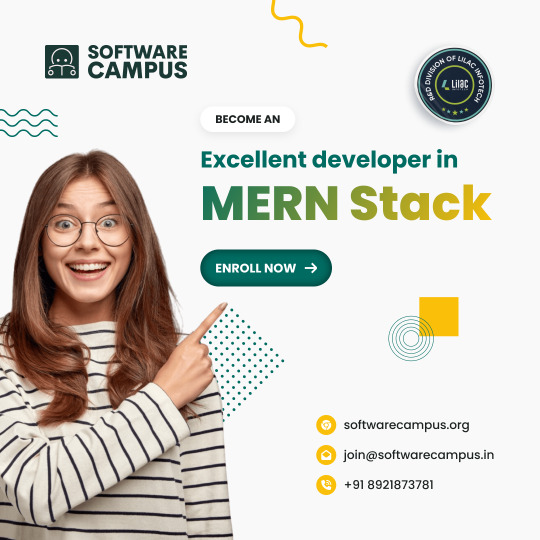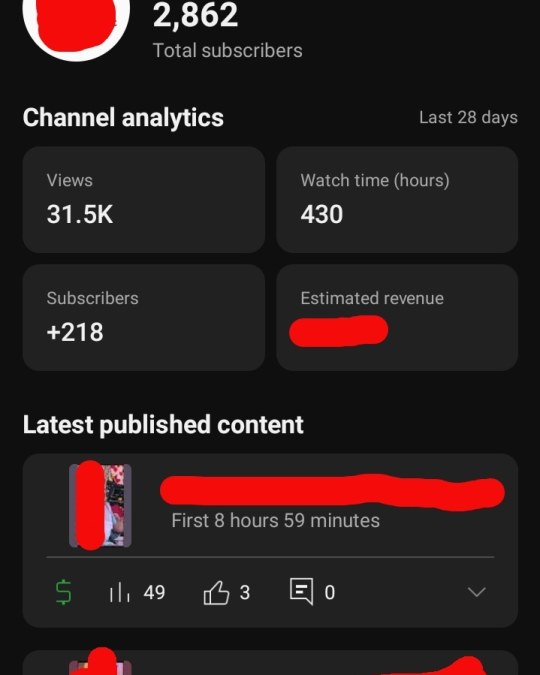#mern stack developers
Explore tagged Tumblr posts
Text
Hire Dedicated MERN Stack Developers Today
Hire dedicated MERN stack developers to build end-to-end JavaScript applications using MongoDB, Express, React, and Node.js for rapid development.

#Hire Dedicated MERN Stack Developers#mern stack developers#dedicated mern stack developers#hire dedicated mern stack developer
0 notes
Text

🚀 Elevate your skills with our MERN Stack Development Certification Program! 🌐💻 Unlock a world of opportunities and become a Software Campus Certified Professional (SCCP) in MERN Stack Development. 📅 New batch starting soon! Don't miss out on this chance to enhance your expertise. 📞 Contact us at +91 8921873781 or 📧 Email us at [email protected] to secure your spot! #MERNStack #SoftwareDevelopment #CertificationProgram #LearnCoding #SCCP #SoftwareCampus
0 notes
Text


Alhamdulillah for everything 😍😍
#hammad sadi#sayyidhammadsaadi#sayyid hammad saadi#sayyidsasadi#saadi#love#viral#style#seo#hammadsadi#developer#mernstack#mern stack developers#react.js#node js application#mongodb#next.js
1 note
·
View note
Video
youtube
Mern Stack Developer | Rakshita: Software Developer | Quality Thought | ...
#youtube#mern stack developers#mern stack developer#stack developer#mern#quality thought#software developer
0 notes
Text

Hyderabad IT Trainings offers an affordable MERN Full Stack Developer course in Hyderabad by Industry experts with 7 real time projects. Our course Includes from basic to advanced level concepts of Full stack development. We have designed our MERN full stack developer course content based on students' requirements to achieve their goal. Register Today.
#mern stack course#mern stack development#mern stack developers#mern full stack course in hyd#mern full stack training in hyderabad
1 note
·
View note
Text
#best mern stack course in hyderabad#mern stack course#mern stack development#mern stack developers#MERN Stack training in hyd#MERN stack course with real time projects
1 note
·
View note
Text
https://gmlsoftlabs.com/why-is-mern-stack-perfect-for-web-application-development/
#mern stack developers#mern stack development#web application develop#web app developers#web application development#software app development#software development company in chennai#website development#software application development#software developers#gmlsoftlabs#best application for forex trading#best node js development company#best react js company in chennai
0 notes
Text
Best MERN Stack Developer Course | Technovids
Join Now for the best MERN Stack Developer Course is designed according to industry requirements. Learn with real-time projects & 100% Placement assistance
1 note
·
View note
Text
How to Integrate Third-Party APIs in a MERN Stack Application

Today’s users are tech savvy, and as the world becomes increasingly digitized, high-performing applications are needed to meet their expectations. MERN stack, which is a combination of MongoDB, Express.js, Node.js, and React, has become one of the most popular frameworks for full-stack web development. It uses cutting-edge programming tools and interfaces to create robust web applications. However, developers often need to integrate real-time data, third-party applications, and additional functionalities into MERN stack application for added benefits.
Developers add Application Programming Interfaces (APIs) to enable applications to communicate with the outside world and exchange information seamlessly. Imagine you want to receive real-time data from a third party service, or input some information into cloud services, then you would require API integration services to perform the task hassle-free. The question, however, is how to do this integration and manage it well within the MERN stack development process.
The Role of API Integration in MERN Stack Applications
With API integration, developers can customize the web application and make it more functional. By integrating external APIs into your MERN stack development process, you can get access to a wide range of services like:

Real-time Data Updates: When you get APIs onboard in a particular application, like getting sports updates, or real-time weather data, live stock market data, you can provide your users with real-time information for a more enjoyable experience.
Third-party Authentication: APIs allow you to connect to highly secured sign-in services such as Google, Facebook, and Instagram. This makes your users feel safe to sign in and give control of their personal resources within the application.
Cloud-services Integration: Using popular APIs from cloud service providers like AWS, Google Cloud, and Azure, you can integrate high in demand features into your app, including machine learning, file storage and serverless computing.
Payment Processing: In most of the e-commerce applications, there is a need to integrate payment APIs from popular payment gateways like PayPal, Stripe, and Payoneer. The MERN stack simplifies secure integration, enabling users to complete purchases seamlessly.
Backend API Integration
The first step in integrating an API into your MERN stack application is to set up a robust backend using the most versatile Node.js and Express.js frameworks. This will serve as the core part of your application holding most of the integration logic of the API. This backend part sources API information, analyzes the data and transmits the results to the front end effortlessly.
However, the detailed process is:
1) Setting Up Express Routes for API Requests: Express.js is a framework in the MERN stack, which is utilized to set up routes that can handle API requests in the MERN stack development process. For example, you can plan routes to fetch weather data, gather news, or send real-time user notifications.
Express routes may handle several functions-
Handling API Requests: Express routes can handle API requests from the frontend efficiently. These requests could be sending the current weather information, or personal information for logging into the user account, etc.
Making External API Calls: After handling the API request, Express can make an API call using its tools. Developers can manipulate and analyze the received API data before returning it to the front end.
Securing API Requests: Sometimes the data received from an external API is confidential and it needs to be handled securely. In such cases, the data is not made available to the users and is stored automatically in the backend. By managing API requests on the server side, there is an additional layer of security developed within your application.
2) Handling API Keys Safely Using Environment Variables: One of the most important points of concern is SAFETY, while working with APIs. API keys often protect APIs, allowing access to them, and these keys must be further safeguarded. In Node.js, developers generally store these keys securely in environment variables. This step allows for an easy deployment of your application to production. Using the environment variables, the API keys are hidden from everyone except the server, thus minimizing the chances of security threats.
3) Error Handling: Another significant concern while integrating APIs in MERN stack development is that APIs can sometimes behave unreliable, or they come with a limit of a certain number of requests an application can make to them within a timeframe. An API may restrict requests to 500 per day or a set number per second. Like only 100 requests in a second. Developers can use Express.js for efficient error handling and rate limiting to prevent application crashes from excess requests.
Frontend API Integration
After fetching and processing backend data via an API, React renders it on the front end. MERN components efficiently load data into React’s virtual DOM for seamless updates. However, for SEO-critical applications, Next.js enables server-side rendering.
NEXT.js helps React with its unique features like server-side rendering (SSR) and static site generation (SSG).
SSR renders pages server-side, sending full HTML to the client, boosting load speed, and enhancing SEO.
SSG generates static HTML during development, ensuring faster loads and better SEO for rarely updated sites.
SSR and SSG make Next.js a performance-optimized framework that boosts SEO rankings. Contact us to hire Next.js developers.
Storing API Data in MongoDB
While API data should be timely, making frequent API requests can be costly, especially in the vase of rate limited APIs. MongoDB helps to overcome this challenge by caching API data, reducing the need for repeated requests.
1) Caching API Data for Performance: Caching is basically a process of storing API data temporarily, like the regularly fetched data (weather, current news, etc), can be fetched without having to call the API next time.
This feature of MongoDB further improves the loading speed of programs, while avoiding the maximum API limits. For example, in an e-commerce application, MongoDB can temporarily store product/service information, reducing the number of API requests and improving the speed on the user side.
2) Storing User Data: MongoDB can store user data like products in the shopping cart, or transaction logs to allow applications to give a personalized user experience regardless of how long the user has been inactive.
Contact us to hire MERN Stack developers.
Leveraging the Combination of Next.js with MERN Stack
Integrating Next.js with the MERN stack enhances business applications, ensuring high performance and scalability. Whether for e-commerce, content-heavy sites, or real-time apps, Next.js adds flexibility and efficiency.
Server-side Rendering (SSR) in Next.js allows you to carry out pre-rendering on the server-side for better first impressions and better search engine rankings. This is particularly helpful for websites that contain HD videos, images, blogs, or have data that needs a change frequently.
Static Site Generation (SSG) in Next.js boosts performance by pre-generating static HTML, enabling instant page loads. This is particularly useful for pages that need rare changes like a company’s product portfolio or marketing pages.
Next.js also enables you to create API routes inside the application, which makes the development easier.
Next.js's Incremental Static Regeneration (ISR) updates static pages in real-time without rebuilding the entire site.
Contact our company to learn more about integrating third-party APIs in a MERN stack app.
Conclusion
APIs when integrated within the MERN stack application, give developers a free hand to experiment with web applications. MERN combines MongoDB, Express.js, React, and Node.js to efficiently handle data storage, manipulation, and related tasks.
Incorporating Next.js into the MERN stack development process adds more value to your developed app as you can leverage its SSR, and SSG features in the development process.
However, many businesses don’t have the right guidance on how to integrate third-party APIs in a MERN Stack application. For them, it becomes essential to join hands with a MERN stack development company that provides experts in MERN stack development as well as Next.js development. Most of the companies also have access to the most advanced tools and technologies, which you may not have otherwise.
Contact us if you are looking for a genuine software development company for your next project.
#hire dedicated mern stack developers#dedicated mern stack developers#hire mern stack developers#mern stack developers#mern stack development company#mern stack developement services
0 notes
Text
Top Reasons to Embrace MERN Stack in 2024

The MERN stack stands out for its unifying language, JavaScript, employed across all components for comprehensive web application development. Comprising MongoDB, an adept document-oriented database; Express.js, a robust web application framework; React.js, a dynamic JavaScript library for crafting user interfaces; and Node.js, a proficient JavaScript runtime environment – the MERN stack's nomenclature derives from the initials of its core components.
Renowned for powering web applications on major platforms like Airbnb, Uber, and Netflix, the MERN stack presents substantial demand for developers, translating into lucrative salary prospects. Venturing into a career in MERN development is a rewarding pursuit, and this article serves as a guide for aspiring professionals on their learning journey.
This blog post explores the advantages of MERN programming, demonstrates how developers can harness its capabilities to construct impressive web applications, sheds light on career opportunities for MERN developers, and outlines the path to proficiency through a Full Stack Development course. Essential skills for success in this dynamic field are also detailed.
What is the MERN stack?
The MERN stack, a widely embraced technology stack for web development, encompasses four key technologies: MongoDB, Express.js, React.js, and Node.js. This full-stack framework offers a comprehensive solution for building scalable and efficient web applications. MongoDB, a NoSQL database, excels at storing and managing data in a flexible, JSON-like format. Express.js, a backend web application framework for Node.js, streamlines server-side development with its minimalistic and robust features.
On the client side, React.js, developed by Facebook, is a powerful JavaScript library for building interactive user interfaces. It facilitates the creation of dynamic and responsive UI components, enhancing the user experience. Node.js serves as the runtime environment for executing server-side JavaScript, fostering seamless communication between the client and server.
The MERN stack's cohesive integration of these technologies enables developers to create modern, single-page applications efficiently. Its flexibility, scalability, and real-time capabilities make it an excellent choice for diverse web development projects. The stack's popularity has grown rapidly, driven by its ability to streamline the development process, foster code reusability, and support the creation of high-performance applications.
How does the MERN stack work?
The MERN stack is a popular technology stack used in web development, consisting of four key technologies: MongoDB, Express.js, React, and Node.js. Each component plays a specific role in building modern, full-stack web applications.
MongoDB: A NoSQL database storing data in a flexible, JSON-like format called BSON.
Express.js: A backend framework streamlining server-side development for Node.js.
React: A front-end JavaScript library for building modular and reusable UI components.
Node.js: A server-side JavaScript runtime enabling the execution of JavaScript code on the server.
In a MERN stack application, React handles the client-side user interface, making the application dynamic and responsive. Node.js with Express handles the server-side logic and communicates with the MongoDB database to store and retrieve data. The entire stack is JavaScript-based, promoting code reuse and allowing developers to work seamlessly across front-end and back-end components.
MERN stack is Easy to learn
The MERN stack is considered relatively easy to learn, especially for developers familiar with JavaScript. Its strength lies in the consistent use of JavaScript throughout the stack, enabling developers to transition seamlessly between front-end and back-end development.
React, as the front-end library, is known for its component-based architecture, simplifying the development of modular and reusable UI elements. Its virtual DOM and declarative syntax enhance the developer experience, allowing for efficient updates and rendering.
Node.js, serving as the back-end runtime, utilizes JavaScript, making it convenient for developers already familiar with the language. Express.js, a lightweight and flexible framework for Node.js, simplifies server-side development by providing essential features like routing and middleware.
MongoDB, the NoSQL database, uses a JSON-like format, making it intuitive for developers to work with data in a flexible and schema-less manner.
Overall, the MERN stack's ease of learning stems from its unified language, strong community support, and straightforward integration of its components, enabling developers to build modern and scalable web applications with efficiency and speed.
Role of Node.js in MERN stack
In the MERN stack (MongoDB, Express.js, React, Node.js), Node.js plays a crucial role as the back-end runtime environment. Key aspects of Node.js within the MERN stack include:
Server-Side JavaScript Execution: Enabling the execution of JavaScript code on the server side, simplifying development and promoting code reuse.
Express.js Integration: Collaborating with Express.js to create a powerful and efficient server environment for MERN stack applications.
API Development: Creating the back-end API for MERN stack applications in combination with Express.js, handling communication between the front-end (React) and the database (MongoDB).
Asynchronous Non-Blocking I/O: Designed to be non-blocking and asynchronous, making it suitable for handling a large number of concurrent connections and enhancing overall performance and responsiveness.
Scalability: Node.js's event-driven architecture and lightweight nature make it scalable, suitable for building real-time applications.
Why you should learn the MERN stack for web development
Learning the MERN stack (MongoDB, Express.js, React, Node.js) for web development provides a comprehensive and powerful toolkit for creating dynamic and efficient web applications. MongoDB, a NoSQL database, ensures flexibility in handling diverse data types, while Express.js streamlines server-side development with its robust and minimalist framework.
React, a popular JavaScript library, simplifies the creation of interactive user interfaces, promoting component-based development and enhancing code reusability. Node.js enables server-side execution of JavaScript, ensuring a unified language across the entire stack. This full-stack synergy accelerates development and fosters seamless communication between the client and server.
Moreover, the MERN stack aligns with industry trends, making it a valuable skill for aspiring developers. Its widespread adoption by tech giants and startups underscores its relevance in today's competitive job market. Mastering the MERN stack empowers developers to build scalable, real-time applications with a modern and user-friendly interface, paving the way for career opportunities and the creation of cutting-edge web solutions.
World's Popular Websites Working on MERN stack
Several popular websites and applications leverage the MERN stack to deliver robust and scalable solutions. Facebook, one of the world's largest social media platforms, utilizes React for its dynamic user interfaces. Additionally, Airbnb, a leading online marketplace for lodging and travel experiences, has adopted the MERN stack to ensure a seamless and responsive user experience.
E-commerce giant Walmart employs Node.js for its server-side operations, enhancing the speed and efficiency of its online shopping platform. The New York Times, a renowned news organization, utilizes React for its interactive and engaging web interfaces, showcasing the versatility of the MERN stack in content delivery.
Furthermore, LinkedIn, a professional networking platform, relies on MongoDB for its flexible data handling capabilities, and Netflix utilizes React for its user interfaces, demonstrating the MERN stack's applicability in the media and entertainment industry. These examples underscore the widespread adoption of the MERN stack across various sectors, emphasizing its effectiveness in building high-performance and feature-rich web applications for a diverse range of purposes.
Skills You Need to Know for MERN Stack Development
Mastering the MERN (MongoDB, Express.js, React, Node.js) stack requires a diverse set of skills spanning both frontend and backend development. Proficiency in JavaScript is fundamental, serving as the primary language for both React on the frontend and Node.js on the backend. A solid understanding of HTML and CSS is essential for crafting engaging and responsive user interfaces.
On the frontend, expertise in React is crucial, encompassing state management, component lifecycle, and the ability to create reusable UI components. Fluency in frontend build tools like Webpack and Babel is also beneficial. For backend development with Node.js and Express.js, knowledge of server-side programming, RESTful API design, and middleware usage is necessary. Familiarity with MongoDB and NoSQL database concepts is vital for effective data handling and storage.
Version control using Git, and collaboration through platforms like GitHub, are integral skills for team-based development. Proficiency in debugging, testing, and knowledge of deployment tools like Docker are valuable for the entire development lifecycle. A comprehensive understanding of asynchronous programming, event-driven architecture, and security best practices further enhances a MERN stack developer's skill set, ensuring they can create robust, scalable, and secure web applications.
Salary Package for a MERN Stack Developer
Salaries for MERN Stack developers can vary based on factors such as experience, location, company size, and industry demand. Salaries are subject to change, and it's advisable to refer to recent salary surveys or consult with local recruitment agencies for the latest information.
In India, MERN Stack developers with entry-level experience might earn anywhere from ₹4 to ₹8 lakhs per annum. Mid-level developers could expect salaries ranging from ₹8 to ₹15 lakhs, while senior developers or those with significant experience might command salaries exceeding ₹15 lakhs.
In the USA, salaries for MERN Stack developers tend to be higher due to factors such as the cost of living and strong demand for tech talent. Entry-level salaries can range from $60,000 to $100,000 per annum. Mid-level developers may earn between $80,000 and $120,000, while senior developers and those with extensive experience may earn well over $120,000, potentially reaching six figures or more.
Conclusion
In conclusion, mastering the MERN (MongoDB, Express.js, React, Node.js) stack for web development emerges as a strategic imperative for aspiring developers. This powerful combination of technologies offers a comprehensive toolkit for creating dynamic, scalable, and responsive web applications. As showcased by the adoption of the MERN stack by major players like Facebook, Airbnb, Walmart, and more, it stands as a testament to its versatility and applicability across diverse industries.
The skills required for MERN stack development span both frontend and backend domains, encompassing proficiency in JavaScript, React, Node.js, Express.js, and MongoDB. Developers must also be adept at various tools, frameworks, and best practices, ranging from Git for version control to Docker for deployment.
The career prospects for MERN stack developers are promising, with competitive salaries and a growing demand for their expertise. Whether in India or the USA, developers with MERN stack skills are well-positioned to contribute to innovative projects and secure rewarding opportunities in the dynamic field of web development. As the digital landscape continues to evolve, the MERN stack remains a valuable asset, offering a pathway to success in the ever-expanding world of technology.
FAQs
Why should I learn the MERN stack for web development?
The MERN stack (MongoDB, Express.js, React, Node.js) offers a comprehensive toolkit for building dynamic, efficient, and scalable web applications. Its versatility and adoption by major companies make it a valuable skill in the tech industry.
What skills are essential for MERN stack development?
Proficiency in JavaScript, React, Node.js, Express.js, and MongoDB is crucial. Additionally, knowledge of HTML, CSS, Git, Docker, and various development tools enhances a developer's skill set.
Which companies use the MERN stack for their web applications?
Major companies such as Facebook, Airbnb, Walmart, LinkedIn, and Netflix utilize the MERN stack, highlighting its widespread adoption across various industries.
What is the salary range for MERN stack developers in India?
Salaries for MERN stack developers in India vary based on experience. Entry-level developers might earn between ₹4 to ₹8 lakhs per annum, mid-level developers between ₹8 to ₹15 lakhs, and senior developers above ₹15 lakhs.
What is the salary range for MERN stack developers in the USA?
In the USA, entry-level MERN stack developers can earn between $60,000 to $100,000, mid-level developers between $80,000 to $120,000, and senior developers well over $120,000.
How does learning the MERN stack contribute to career opportunities?
Mastering the MERN stack opens doors to diverse career opportunities, aligning with industry trends and meeting the demand for developers capable of creating modern, real-time web applications.
What are the key components of the MERN stack that make it advantageous?
The MERN stack's key components include MongoDB for flexible data handling, Express.js for server-side development, React for interactive user interfaces, and Node.js for server-side execution of JavaScript.
How does the MERN stack cater to the evolving expectations of web users?
The MERN stack enables the creation of responsive, feature-rich web applications, aligning with evolving user expectations. Its adaptability and efficiency make it a valuable asset in the rapidly changing digital landscape.
0 notes
Text

🚀 Master MERN Stack Development with SCCP! 🌟 Become a Pro in the World of Web Development. 💼 Join our SCCP Program now! 📞 Contact us at +91 8921873781 or ✉️ Email us at [email protected]. 👩💻 Seats are filling fast! Secure Your Spot Today!
#mern stack#full stack courses#IT courses#mobile app#internship#six month#3 month#hiring#job oriented#cyberpark#kozhikode#calicut#kerala#web development#mobile app development#software institute#job#techjob#mern stack developers#MERNSTACK development#software
0 notes
Text

Alhamdulillah 2.5k+ Subscribe done
#hammad sadi#sayyidhammadsaadi#hammad#viral#style#musician#hammadsadi#developer#love#seo#syedsadibd#sayyid hammad saadi#mern stack development#musicians#social media#mernstack#mern stack developers#mern stack#mern stack course#react#youtubeseo#youtubemarketing#youtuber#youtube monetization#monitization#youtube monetization Prof
1 note
·
View note
Text

The MERN development consist of 7 imporatant applications in which MongoDB acts as a database to store and retrieve data. Express.js and Node.js handle API's, routing and server side logic. React is used to the front-end library to build reusable UI componenets and manage application state. HTML, CSS, and JavaScript are used to create the user interface and handle client-side interactions. Alltogether, these tools provide a efficient and comprehensive stack for developing applications.
#mern stack developers#mern development#it solutions digital marketing#kochi#web development kochi#web development#web development agency
1 note
·
View note
Text
Build scalable web interfaces and robust applications with the best Mern stack development company. Our Mern stack developers offers unique and custom Mern stack development services.
0 notes
Text
🚀 Struggling to find a job because of lack of experience? It’s time to break the cycle with PSK Technologies Pvt. Ltd.!
Join our 180-day Full-Time Training & Internship Program and gain the skills and experience you need to kickstart your IT career.
👉 Your bright future starts here with PSK Technologies Pvt. Ltd.
#pskteam#aws#pskitservices#psktechnologies#psknagpur#websitedesign#linux#bestitcompany#mernstack#webhosting#mern stack development company#mern stack development services
2 notes
·
View notes
Text
Frontend Frameworks for Web Development

Frontend Frameworks for Web Development, creating captivating and user-friendly websites and web applications is essential for businesses to thrive. With the increasing demand for dynamic and interactive web experiences, frontend development has become more crucial than ever.
To meet these demands efficiently, developers rely on frontend frameworks, which streamline the development process and enhance productivity.
In this comprehensive guide, we'll explore the world of frontend frameworks for web development, covering everything from key factors to consider when choosing a framework to the top options available in India.
Overview of Frontend Frameworks for Web Development
Frontend frameworks are collections of pre-written code, libraries, and tools that expedite the process of building user interfaces for websites and web applications.
These frameworks provide developers with a structured approach to frontend development, offering ready-made components, templates, and utilities to streamline common tasks.
By leveraging frontend frameworks, developers can achieve consistency, maintainability, and scalability in their projects while focusing more on functionality and user experience.
These frameworks often follow the principles of modularization and component-based architecture, facilitating code reuse and making development more efficient.
Key Factors to Consider in a Frontend Frameworks for Web Development
When choosing a frontend framework for web development, several key factors should be considered:
Community Support: Opt for frameworks with active and robust communities. A strong community ensures ongoing support, frequent updates, and a wealth of resources such as documentation, tutorials, and plugins.
Performance: Evaluate the performance metrics of the framework, including page load times, rendering speed, and resource utilization. A lightweight and efficient framework can significantly impact the user experience.
Flexibility and Customization: Assess the framework's flexibility in accommodating project requirements and its customization options. Look for frameworks that allow developers to tailor components and styles to suit specific design needs.
Learning Curve: Consider the learning curve associated with the framework, especially if you're working with a team of developers with varying skill levels. Choose a framework that aligns with your team's expertise and resources.
Compatibility and Browser Support: Ensure that the framework is compatible with a wide range of browsers and devices, particularly if your target audience includes users with diverse preferences and devices.
Updates and Maintenance: Check the framework's update frequency and long-term maintenance plans. Regular updates and proactive maintenance are essential for addressing security vulnerabilities and compatibility issues.
7 Best Frontend Frameworks for Web Development in India
Now, let's explore some of the top Frontend Frameworks for Web Development widely used by developers in India:
React.js: Developed by Facebook, React.js is a popular JavaScript library for building user interfaces. It emphasizes component-based architecture and virtual DOM for efficient rendering. React's ecosystem includes tools like React Router for routing and Redux for state management.
Angular: Backed by Google, Angular is a comprehensive frontend framework for building robust web applications. It provides features such as two-way data binding, dependency injection, and modular development. Angular offers a full-fledged ecosystem with Angular CLI for project scaffolding and Angular Material for UI components.
Vue.js: Vue.js is an advanced JavaScript framework known for its simplicity and flexibility. It allows developers to incrementally adopt its features and integrate it into existing projects easily. Vue.js offers reactive data binding, virtual DOM, and a rich ecosystem of plugins and components.
Bootstrap: Bootstrap is a popular CSS framework for building responsive and mobile-first websites. It provides a grid system, pre-styled components, and responsive utilities, allowing developers to create sleek and consistent designs quickly. Bootstrap is highly customizable and offers extensive documentation and community support.
Svelte: Svelte is a relatively new frontend framework that focuses on compiling components at build time rather than runtime. This approach results in highly optimized and lightweight web applications. Svelte's simplicity and performance make it an attractive choice for developers seeking efficiency and speed.
Tailwind CSS: Tailwind CSS is a utility-first CSS framework that provides a set of low-level utility classes for building custom designs. It offers a highly customizable and expressive approach to styling, enabling developers to create unique and responsive interfaces without writing custom CSS. Tailwind CSS is gaining popularity for its developer-friendly workflow and rapid prototyping capabilities.
Foundation: Foundation is a responsive front-end framework developed by ZURB, known for its modular and customizable nature. It offers a comprehensive set of CSS and JavaScript components, as well as a robust grid system and a variety of UI elements. Foundation is well-suited for building modern and accessible web projects.
Conclusion for Web Development
Choosing the right Frontend Frameworks for Web Development is crucial to the success of your website development. Consider factors such as community support, performance, flexibility, and compatibility when evaluating different frameworks. Each framework has its strengths and weaknesses, so assess your project requirements and development preferences carefully before making a decision.
Whether you opt for React.js, Angular, Vue.js, or any other frontend framework, prioritize learning and mastering the chosen tool to maximize its potential and deliver exceptional web experiences. Keep abreast of new developments, best practices, and emerging trends in frontend development to stay ahead in this ever-evolving field.
FAQs for Web Development
Q: Which frontend framework is best for beginners?
A: Vue.js and React.js are often recommended for beginners due to their relatively gentle learning curves and extensive documentation.
Q: How do I choose between Angular and React for my project?
A: Consider factors such as project requirements, team expertise, and ecosystem preferences. Angular offers a comprehensive solution with built-in features, while React provides more flexibility and a vibrant ecosystem.
Q: Are frontend frameworks necessary for web development?
A: While not strictly necessary, frontend frameworks greatly simplify and expedite the web development process, especially for complex and dynamic projects. They provide structure, consistency, and efficiency, ultimately enhancing productivity and user experience.
Q: Can I use multiple frontend frameworks in the same project?
A: While technically possible, using multiple frontend frameworks in the same project can lead to complexity, conflicts, and maintenance challenges. It's generally advisable to stick to a single framework to maintain code consistency and streamline development.
More Details
Email: [email protected]
Website: https://censoware.com/
#web development#website development#software development#web developers#pythonprogramming#phpdeveloper#javascriptdeveloper#mern stack development#mobile app development
2 notes
·
View notes